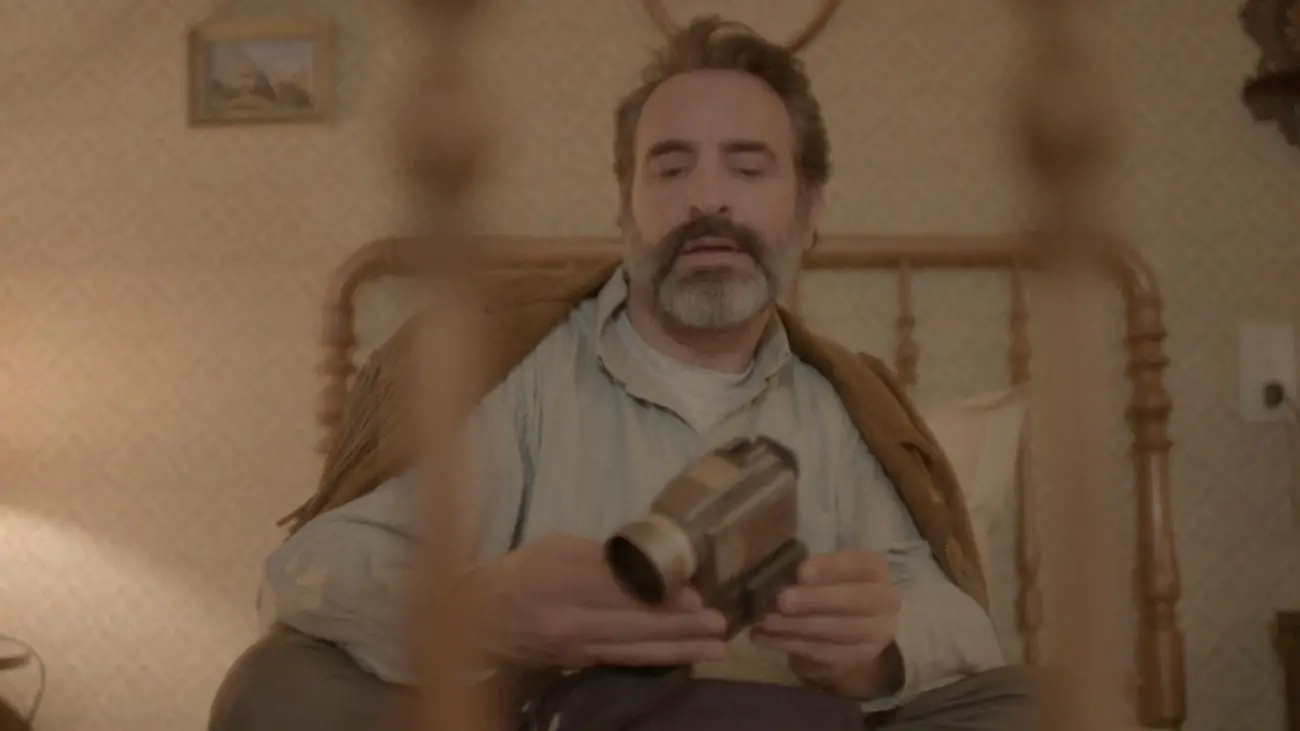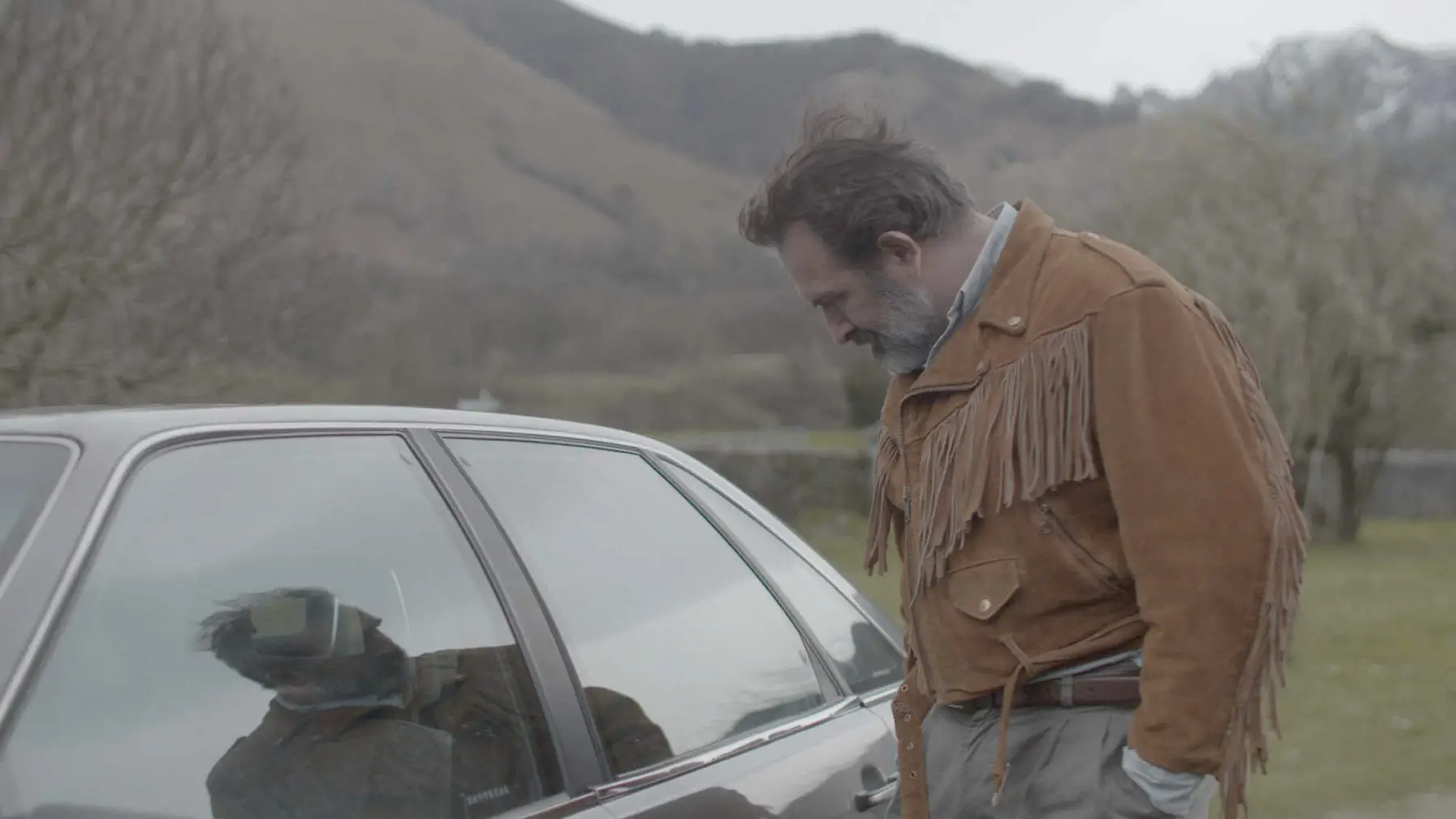In analysing the 2019 Quentin Dupieux film Deerskin, there comes an acceptance that extrapolating deeper meanings from an absurd plot in Dupieux’s cinematic world is an act of self-parody. Through a study of narcissism’s consequential delusions, Deerskin offers up a ridiculous ‘love’ affair between a man and his jacket. With an exploration of the philosophical absurd, a character’s actions are justified only to themselves in their ego-inebriated states. Dupieux is a director who consistently employs bizarre plots, surreal motifs, and off-kilter humour, though Deerskin, whilst deranged itself as an entity, represents his most refined and composed film. Though this analysis intends to look specifically at the philosophy of absurdism in Deerskin, establishing this philosophy’s definition and prominent cinematic appearances will aid in identifying how Dupieux utilises this as a plot device and theme.
As a philosophy, broadly, absurdism is the embrace of one’s purposelessness in a chaotic and irrational universe. The absurd being the result of contradictory conflict between the human mind and the nature of a random universe. In semblance with existentialism and nihilism, absurdism acknowledges that the individual’s choice(s) can shape meaning in their life. In film, the expression of absurdism has been portrayed in various manners. From Woody Allen’s introspective satire Zelig, Terry Gilliam’s surreal kafkaesque dreamland Brazil, and Andrej Zulwaski’s Cosmos where unjustified clues lead to larger puzzles, but all roads lead to nonsense. Ultimately, an absurdist film tends to project a life lived in, acknowledging the meaninglessness void that is the irrational universe. Absurd worlds and universes, by definition, allow a degree of unexplained circumstances for characters to be victim to, propagators of, or to explore. For Dupieux, the absurd world stems directly from his protagonist in Deerskin, Georges (Jean Dujardin) and his bizarre grasps at a sense of direction.

Georges, a loser by all conventional means, is fleeing, leaving his former life behind, seeking isolation in the French Alps. However, the masculine fantasy of simply leaving it all behind is quickly replaced by a new purpose: the acquisition of a second-hand deerskin jacket seen in an advertisement. Played by the charismatic Jean Dujardin (The Artist), he brings his brand of charisma and charm to this pitch-black blend of comedy and horror. Whilst seemingly cast out of his marital home, there is an air of relief about Georges; his ex-wife abruptly informs him he is ‘nowhere’ in one of the few brief and icy phone calls between the pair. The early acquisition of the film’s centrepiece item, the deerskin jacket, reaffirms Georges rejection of a life left behind, cementing unwarranted confidence in himself henceforth.
Upon his expensive purchase of the jacket, the aloof salesman Monsieur B (Albert Delpy) decidedly throws in a digital video camera into the purchase. Whilst he is initially taken aback by the inclusion of said camera, Georges slowly begins to flirt with the item in his hotel room. Eventually, the camera becomes a pivotal plot device to accompany the jacket. In looking to remain lost, Georges checks into the local hotel; with no money, he offers up his wedding ring to guarantee future payment to the unflustered attendant. This willingness to discard pre-jacket life at ease; the wedding ring now only holding monetary value is another example of a need for a new direction. Dupieux employs props as McGuffins; firstly, the jacket, secondly, the video camera. For Georges, the interaction between the two essential items is what enshrines his delusional state and his new purpose in a world he previously held no control over.
To learn more about his new toy—the camera—Georges begins to record himself in his hotel room talking to his new jacket. Here, the first McGuffin, the deerskin jacket, gains a level of sentience that enables the plot to progress from a limp escape to isolation to a symbiotic relationship between man and his new favourite item of clothing. A mimicry of conversation begins until the inanimate object of his affections begins to call the shots; Georges must destroy all other jackets. A lofty task and an absurd plot, this dream or mission as it seems enabled by the other object—the video camera. “Are you talking about my jacket?” Georges arrogantly proposes to barmaid Denise (Adèle Haenel) and a local prostitute appearing to whisper conversation amongst themselves across the bar. Upon meeting Denise, Georges lies about his job when asked; thanks to his new video camera, he fancies himself a filmmaker.
Later that evening, returning to his hotel room, Georges hears a loud noise in the night. The next day, Georges is about to slink out quietly in hopes of financing his stay; the proprietor of the hotel now sits where the employee once did. Explaining his current situation, he informs the proprietor of his guarantee exchange with his wedding ring. He is sharply informed the employee who took in the said ring had committed suicide that night—the loud noise previously heard was a gunshot. Told he had no family, the employee’s death is nonchalantly brushed off and Georges concerns seemingly flit immediately to reacquiring his ring. The casual discussion of suicide and death itself is strikingly absurd in both men’s reactions—whilst Dupieux takes this a step further and shows us the mangled body lying in a backroom as if waiting to be discarded in the garbage. Whilst missing the majority of his face, the body, arms folded, is wearing his ring; Georges does not hesitate to remove it from the cadaver’s finger or take the late employee’s suede hat for himself.
The mission—eradicating all other jackets—begins in a less sinister endeavour than it ends. The camera records the frivolous requests: take off your jacket. Georges’ hubris encompasses all, so such a bizarre task becomes an almost endearing journey of self-discovery. Denise, another fascinating character, tells Georges of her desire to be a film editor, having something of a hobby re-editing films. There is no transference in delusions of grandeur; Denise is firmly confident in herself. A thematic point of reference allows the film to shift from a masculine search for identity into a much deeper tale of absurdism—from the Fight Club–esque fragility of man’s longing for identity to the shared search for a purpose in Columbus or Lost in Translation. Denise fully commits to the faux filmmaking ruse she is sold, giving Georges her time and money to fulfil his elusive quest. Even in the eventual descent into violence and murder that are consequences of a frustratingly daunting task for Georges, Denise remains focused.
Though explicitly brutal, the murders committed by Georges when acquiring local townsfolk’s jackets always retain a comedic element. Without ever appearing to be personal, the murders are a natural progression from asking for garments to simply needing to speed up the acquisition—at his own jacket’s demands. The kitsch violence ensures the film remains very much in line with Dupieux’s usual output as a filmmaker. Ironically it is one of the non-lethal encounter’s that leads to an act of retribution against Georges; a young boy who appears to irk the protagonist is struck down for following him, perhaps an admirer of his jacket. This boy’s father shoots an unsuspecting Georges, now adorned in an entire outfit of suede—thanks to Denise. Georges falls to the ground; before the dust has settled, Denise takes the jacket for herself and films this—Deerskin has come full circle, the jacket has a new owner.

Whilst much of the film focuses on Georges newfound purpose in the face of a world he once felt cast out by, there is a palpable sense of pointlessness in Denise’s character. The latter, working long hours at a local bar in a small village when creative, with her ‘smart machine’ brain able to edit Georges nonsensical recordings into some form of mockumentary narrative. Georges never quite reaches the level of sinister narcissism in his own absurd world devoid of any meaning that perhaps American Psycho’s Patrick Bateman or The House That Jack Built‘s Jack reach, the Frenchman’s lacking intelligence allows him to retain his endearing loser status. Though Denise never exhibits physical violence towards anyone, she is unaffected by Georges’ murders that he shows her through the recordings he provides for her to edit.
In the knowledge that Georges actually isn’t a filmmaker and there are no producers, in Siberia, or anywhere else he may claim, Denise still sees a project within their acquaintance. Despite all of the ensuing chaos and point-blank executions, she pines for Georges’ jacket. As if the film within the film communicates with her, the moment she can cloak herself in the tasselled deerskin jacket is resoundingly satisfying. Both characters’ object of desire is elevated as if offering the sense of direction both appear to seek; the absurd solution rectifies the absurd world. Dupieux’s Deerskin placates the characters and audience alike with the bizarre and surreal notion a new coat can bring a form of catharsis in our irrational lives. The sentiments of consumerism and the inherent value we, as a society, place in inanimate objects of clothing or objects of other functions to comprehend the randomness of everyday life is proposed playfully by Dupieux, even as madness takes hold.



